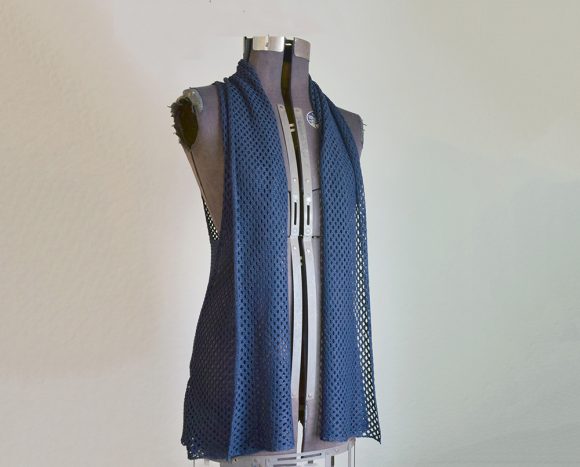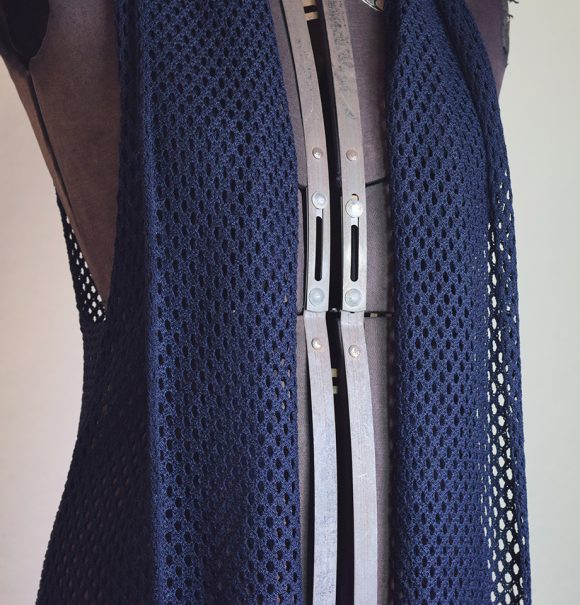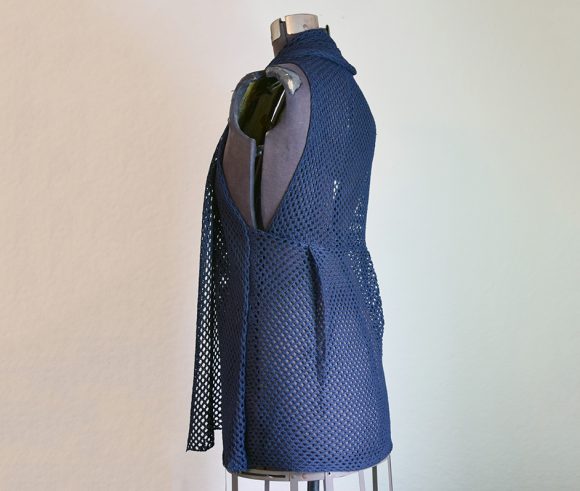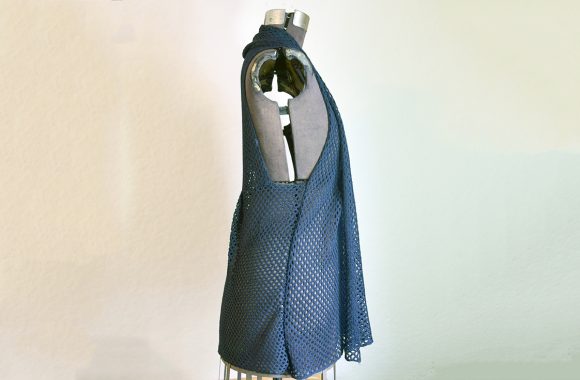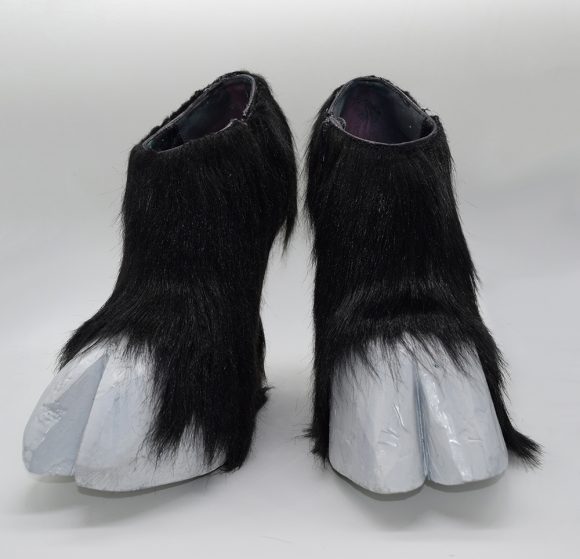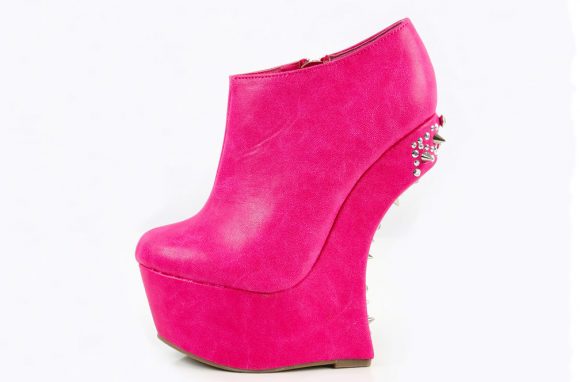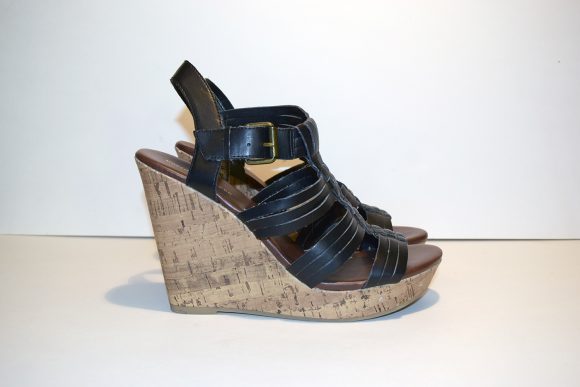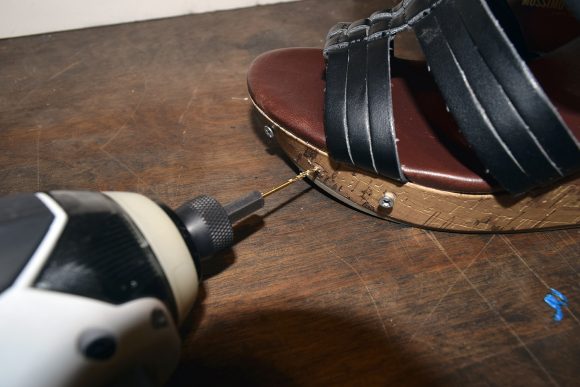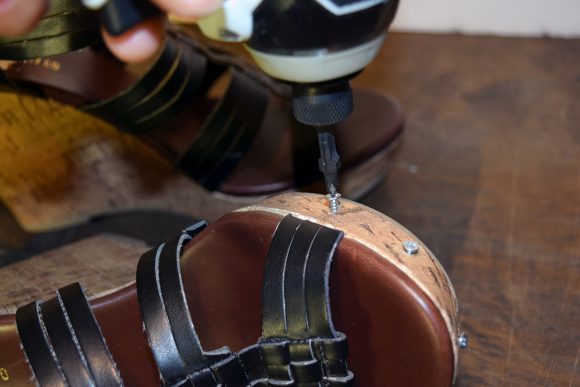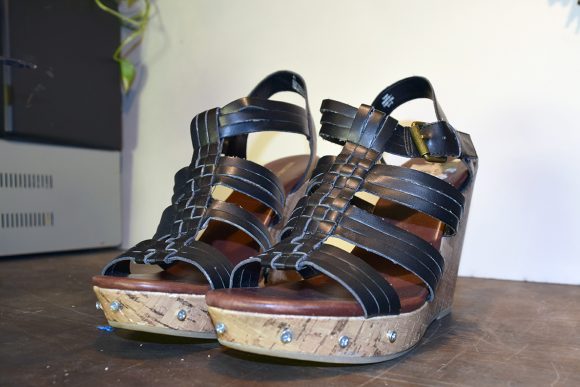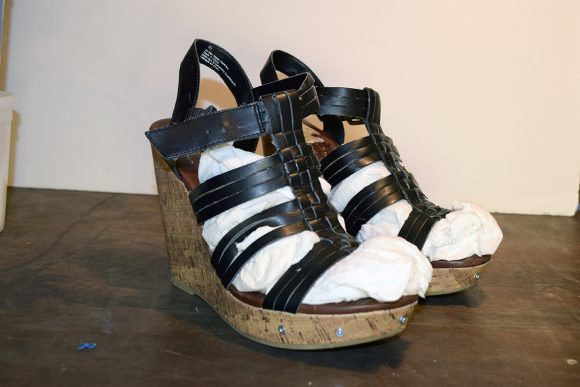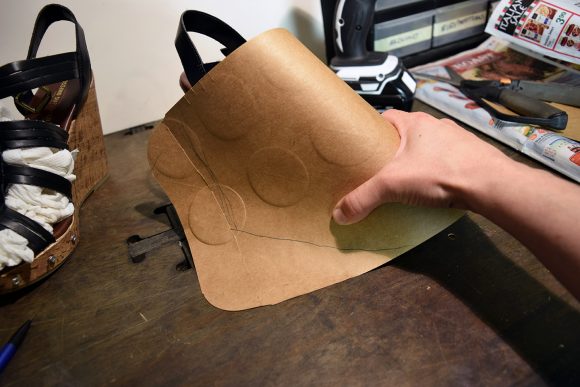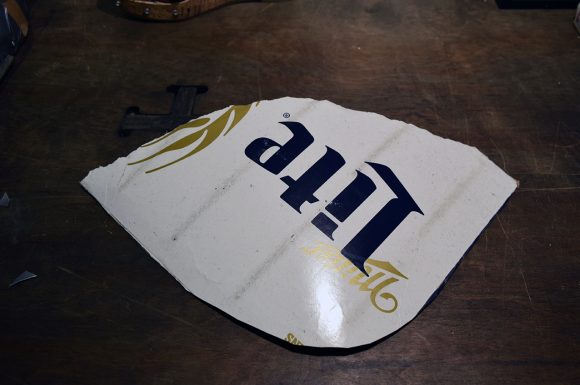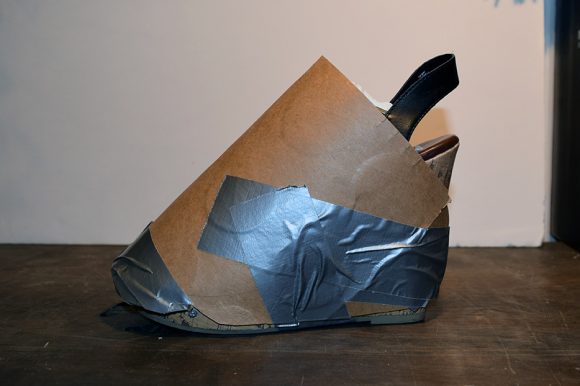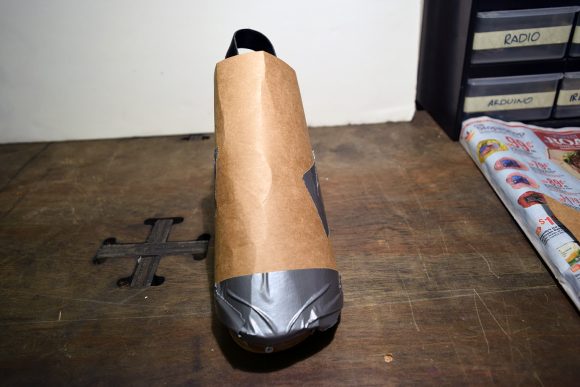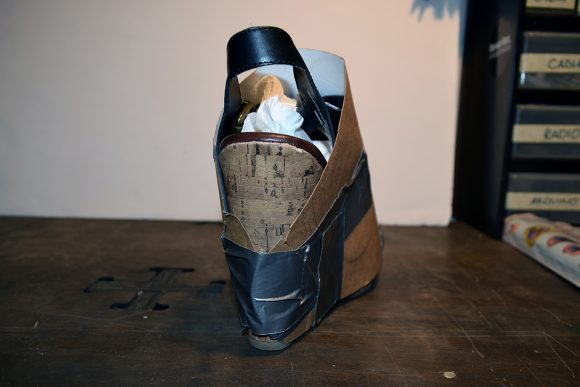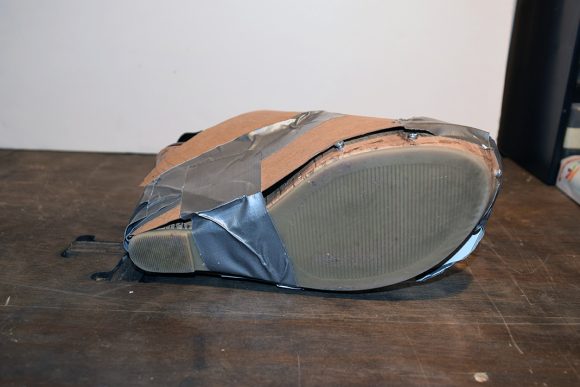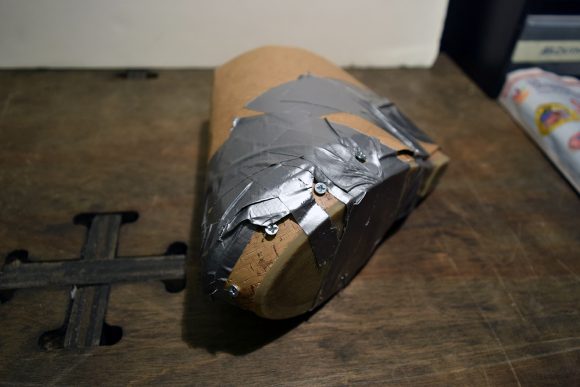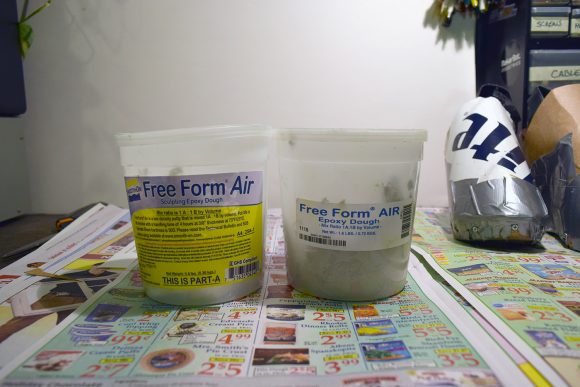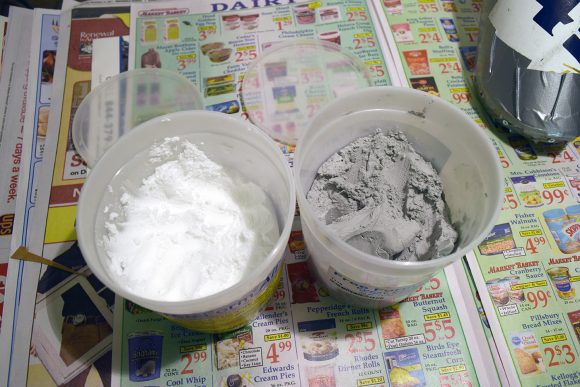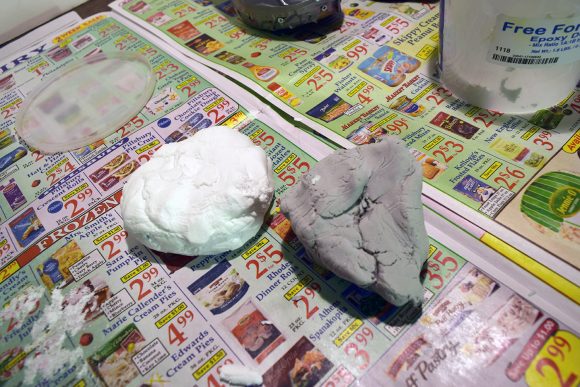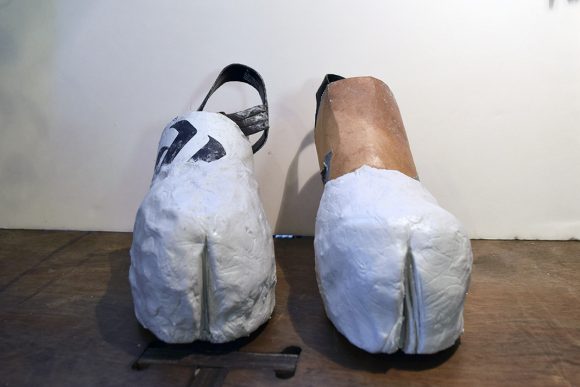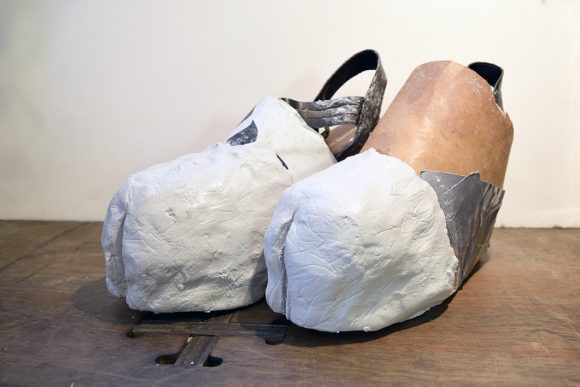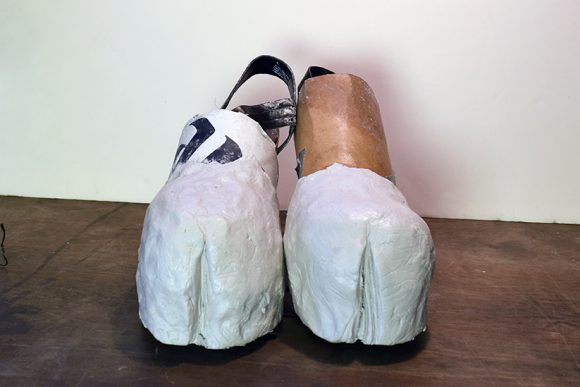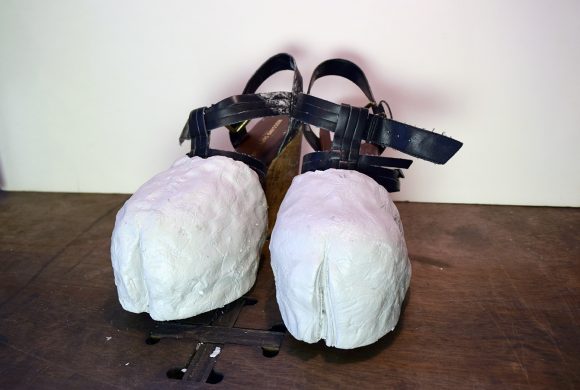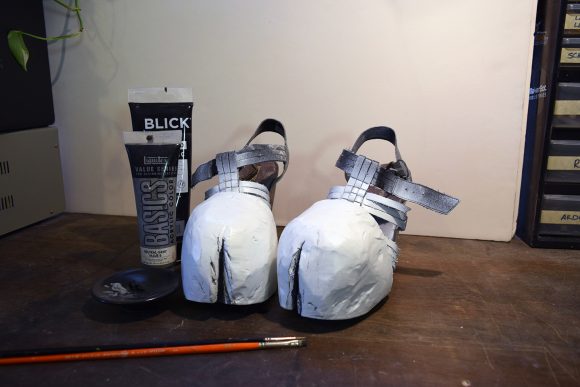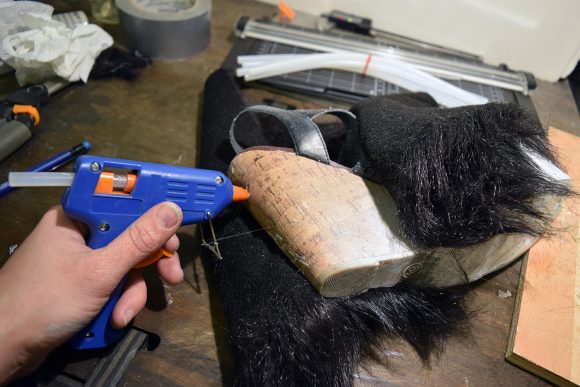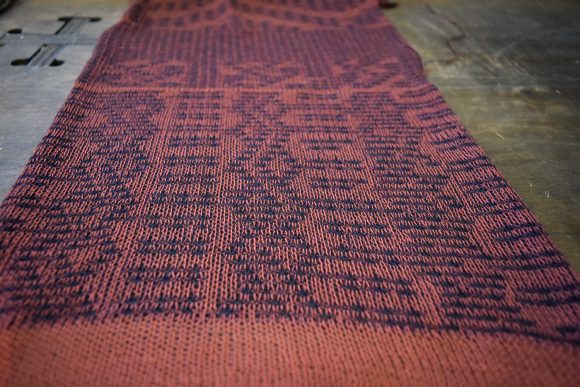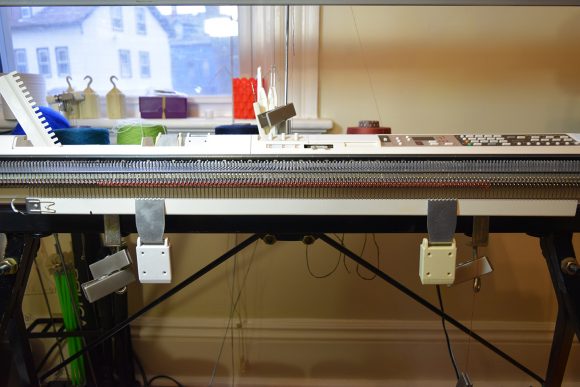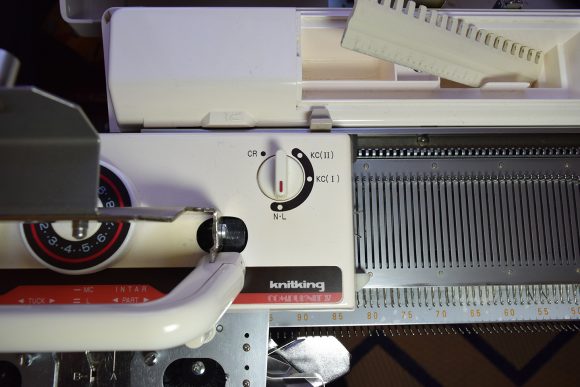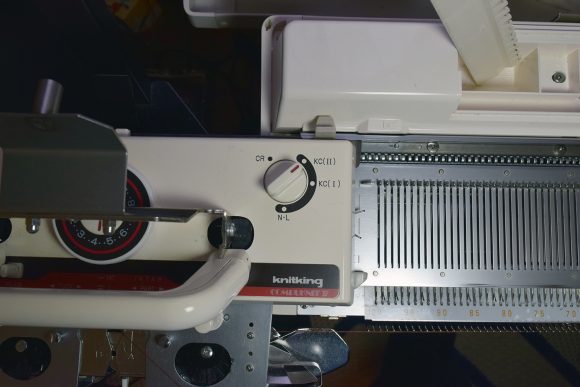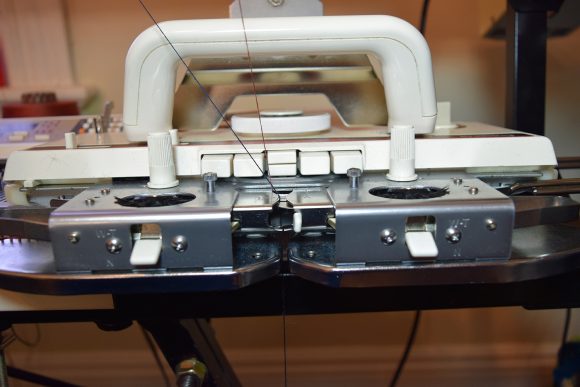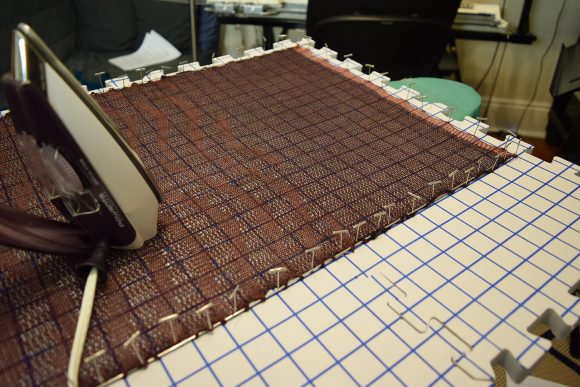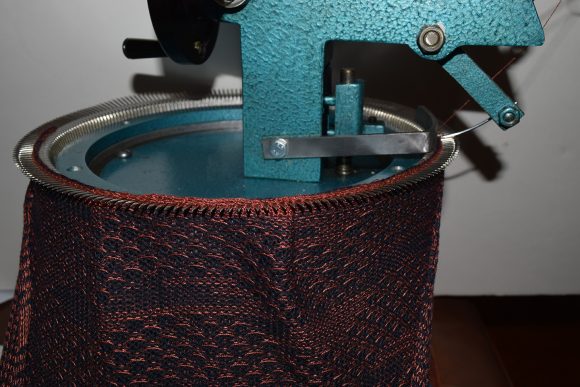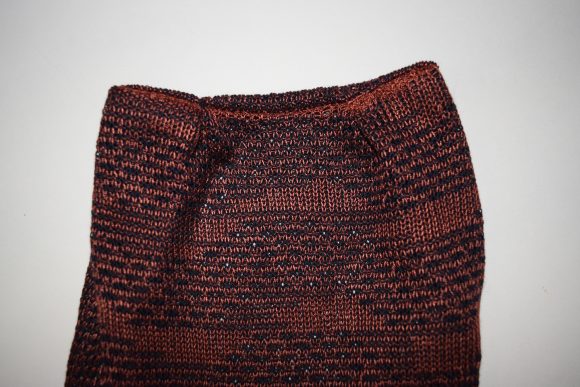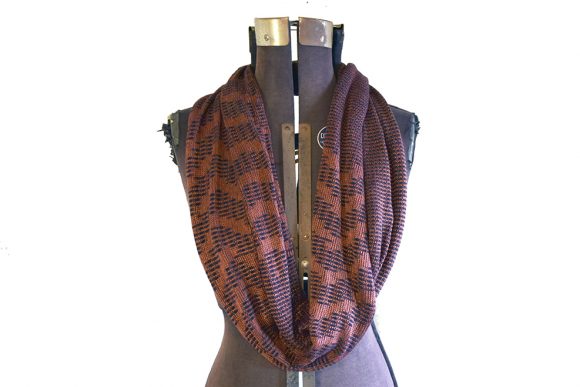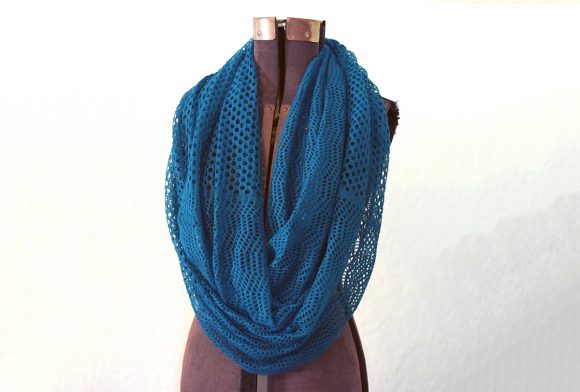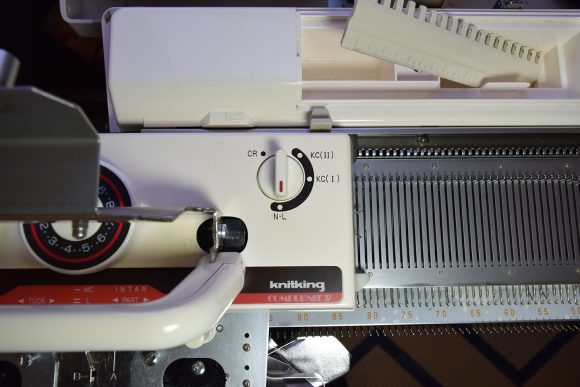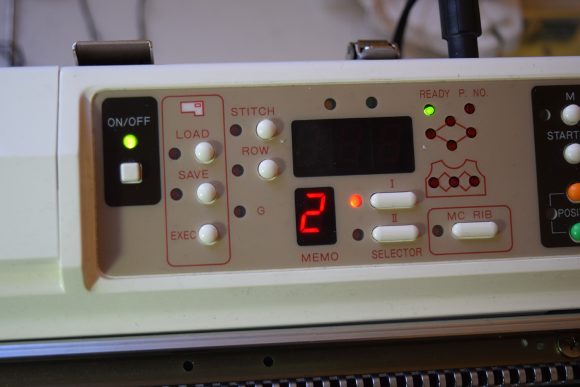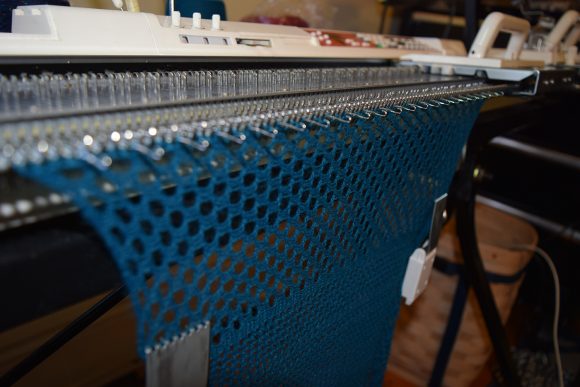I made this vest from navy blue wool crepe yarn on my Knitking Compuknit V knitting machine using Brother pattern 104, which looks like large crocheted eyelets. The vest itself is made from three simple rectangles. One rectangle forms the vest front, a small square forms the yoke in the back and a third created the back and sides of the vest.
Category: Sewing / Fashion / Costume
To make a pair of hoof shoes, you’ll need the following:
- suitable shoes
- SmoothOn Free Form Air epoxy dough
- small screws
- drill and bits
- sander discs for a drill
- paint
- fur
- hot glue gun and glue
- thin cardboard (optional, depends on shoes chosen)
Step 1: Find Suitable Shoes
There are two basic ways to make hoof shoes: start with heelless shoes (like those shown below) or to use a wedge. The heelless shoes typically have two-inch platform soles, which makes them a great canvas for adding hooves, but they are difficult to walk in. Although I used them to make the booties shown above, I was worried about breaking an ankle the entire time I was wearing them.
To create a “hoof look”, you want to minimize your footprint
The goal of hoof shoes is to make it look like you have hooves instead of feet. In order to create this illusion, you’ll need to select shoes that have as small of a sole as possible. Meaning, the higher the heel, the smaller the sole of the shoe. However, you’ll need to balance being able to walk with small sole size.
Platform or chunky sole needed
The hooves themselves are made from SmoothOn Free Form Air lightweight epoxy. In order to get the hooves to stick to the shoe, you’ll need adequate surface area and anchors for the epoxy to grip. Practically, this means that the shoes you select will need to have a slight platform or a chunky sole that you can drill into to add anchor screws for the epoxy to grip.
Having made two pairs of hoof boots, one with heelless shoes and one using a wedge shoe, I recommend using the wedges. Heelless shoes shift all of your weight onto the toes and can be very uncomfortable to wear for long periods of time. This tutorial uses a strappy wedge shoe with a very slight platform. Wedges are much easier to stand in, as you can rest your weight on your heels as well as the toes.
Make a on/off fastener plan
Depending on the shoes you choose, you may need to be creative in how you arrange the fur so you can take the shoes on and off. For example, the boots I used to make the heelless shoe hoof shoes had zippers on the side. I needed to leave that zipper open and arrange the fur around them so the zipper could still open and close.
For the buckle wedges used in this tutorial, I made a plan to wrap the fur around the tops of the shoe in a flap that would attach with buttons that ran up the leg, forming knee-high boots that were secured with elastic at the top. The flap needed to open all the way up so I could get to the buckles.
Step 2: Drill Holes
Drill several holes equally spaced around the front of the toe, in the shoe’s chunky sole or platform area. Drilling holes makes it easier to add the screws.
Step 3: Add Screws
Using an impact driver or a screw driver, add screws to each of the holes you created in the previous step. But, don’t drive the screws all the way into the shoes. Make sure the screw heads stick out from the sole, you want them to act as anchors to hold the epoxy in place.
Step 6: Stuff Shoes with Paper Towels
Epoxy has a tendency to shrink around the toes of the shoes as it cures, making them tighter. Combat this and ensure you can get your feet into your shoes by stuffing them tightly with paper towels. If you are using strappy shoes that you need to cover with cardboard (like those shown in this tutorial), this helps to keep the form of your foot as you apply the cardboard. Otherwise the straps will flatten out and the toe area becomes shapeless.
Step 5: Add Cardboard
If you are working with covered shoes, you can skip this step (and all the “cardboard” steps that follow), moving on to Step 8: Prepare and Mix Epoxy Dough. However, if your shoes are strappy and open at the top, this next step is vital.
Make your pattern
Take some very thin cardboard (I used Miller Lite beer case packaging) and wrap it over the top of the shoe. Take a marker and draw a line where the cardboard meets the sole of the shoe. You’ll use this line to trim the cardboard to make it fit the shoe top.
Trim your pattern
Trim your pattern along the marker lines with scissors.
Step 6: Duck Tape Cardboard
Use Duck tape to attach the cardboard to the shoe. Make sure to wrap it around the bottom of the sole so it doesn’t move around. This cardboard is the canvas for the attachment of the hoof and it creates the space for your foot inside the hoof, so make sure it is firmly attached and well propped up / pushed out with paper towels or rags.
Don’t worry about the duct tape showing on the sole, you’ll remove it after you create the hooves. Also, the duct tape won’t be the primary force holding the cardboard to the shoe. You’ll be trimming most of the cardboard away in a later step and the epoxy will hold the toe together.
Step 7: Trim Cardboard
Trim the cardboard around the screws, remember that the screws are anchors for the epoxy and that they must protrude from the sole. You’ll also want to make sure that the toe is completely sealed, meaning that the duct tape attaches the cardboard firmly across the entire width of the toe box area. Attach more duct tape if necessary around the toe / sole area.
Step 8: Prepare and Mix Epoxy Dough
With the shoe prep complete, it’s time to mix the SmoothOn Free Form Air epoxy dough. This stuff comes in two separate containers and it activates when mixed by hand. Don some gloves and follow the instructions that come with the dough. To mix it, I found it easiest to flatten the dough, then fold in half over and over again.
Step 9: Apply Epoxy to Shoes
After you mix the Free Form Air together, you’ll have about 20 minutes working time before it starts to cure and become hot. This is plenty of time to form your hooves.
TIP: Use an old credit card or some other plastic card to made the slits in the hooves.
Remember, you want to make the hoof as small as possible, but you still want to cover the entire toe area, with enough room for the cloven slits in the front.
Step 10: Allow to Cure for 24 Hours
After 24 hours, your shoes will be completely cured, dry, and ready for sanding.
Step 11: Trim Away Cardboard
Now that the epoxy has cured, you can trim away the cardboard that stuck up above the epoxy and the duck tape that wrapped around the soles.
Step 11: Paint
Paint the hooves any color you like. I used white acrylic spray paint on the main hoof, then brushed on black and grey acrylic paint on the cloven slit area to accentuate it. I then added a few streaks to the rest of the hoof to add texture.
After letting the paint dry, I added a several coats of clear spray acrylic to protect the paint job.
Step 12: Add Fur
Get out your hot glue gun. Starting at the hoof area, add a large amount of glue, then stretch the fur, pulling it tight over the top of the shoe. Cut the fur, stretching and gluing as necessary to cover the entire shoe.
TIP: Make sure that any zippers or buckles on the shoes are accessible! Otherwise you won’t be able to take the shoes on and off. Make a plan from the beginning on how you will deal with these fasteners.
To finish the tops of the shoes, I sewed buttons onto the fur, creating knee-high boots that buttoned up the side and secured them with elastic at the top. If you are working with covered shoes, the finishing task is much easier, you simply need to cover the shoes.
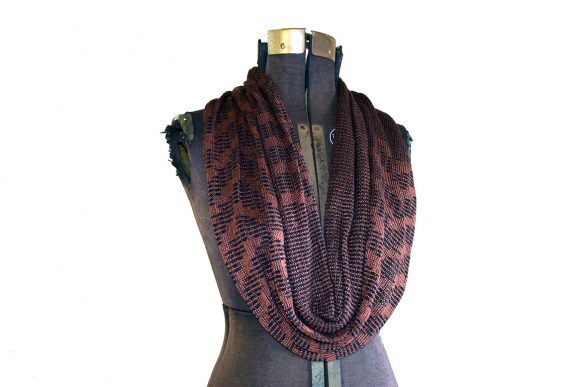
I knit this ultra-thin scarf on my Knitking Compuknit 5 (Brother KH-965) knitting machine using a combination of copper tencel/rayon and navy cotton thread. I started by prototyping the fabric, testing numerous thread lace patterns with multiple materials until I found a combination and tension (one notch above 4) that worked well.
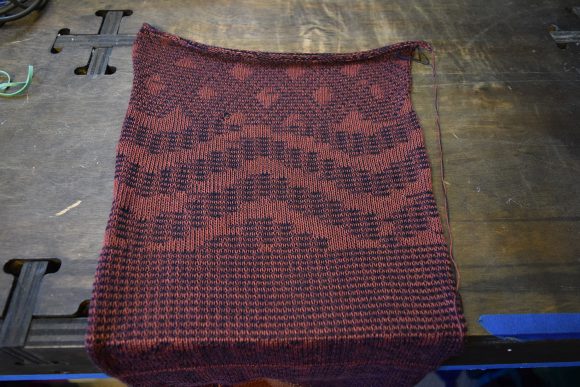
I choose a “wavy lace” pattern (Brother Stitchworld #413) and the plainer #420. Then I hooked up my motor drive and knit about 100 rows of #420, followed by about 200 rows of #413, before switching back and finishing up with #420.
Here’s how to make your own:
1. Cast on 100 needles (needles 50 to 50). I used a closed, crochet, or chain, cast on, it makes the seaming easy when it’s time to join the scarf edges.
2. Knit a row at tension 4, then hang your weights.
2. With the K carriage knob set at “NL” for plain knitting, knit two or three rows in stockinette, ending with the K carriage past the left turn mark.
3. With your K carriage positioned outside the left turn mark, set your K carriage to “KC II” for pattern knitting with end needle selection.
4. Move the K carriage across the needle bed once, and the needles will pattern.
5. With the K carriage on the right side of the bed, push in both center buttons, “MC” and “L”.
6. Load up your second color thread into your secondary tension mast and through K carriage yarn feeder B.
7. Knit the scarf. I typically knit then measure as I go. This scarf measured 94 inches.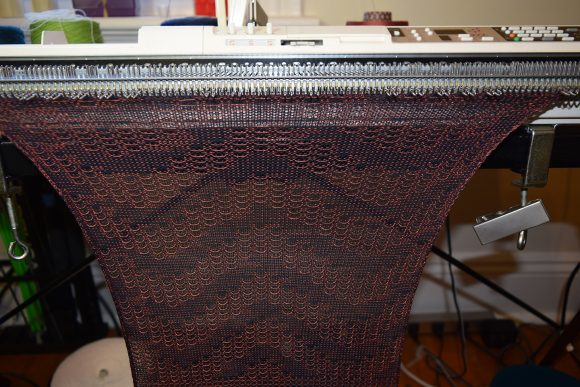
8. Bind off either by hand, or with a linking accessory.
9. After binding off, wash the scarf and while wet, steam block the it within an inch of its life with a steam iron, to discourage curling edges.
For my scarf, the steam attempt to uncurl was marginally successful, but worked well overall. The edges still curled, but the bulk of the fabric unwound and draped nicely.
10. Join up the edges by hand or with a Hague linker (shown in blue below), and the scarf is ready to wear.
11. Optional: add tucks to the linked edge of the scarf so it has a more streamlined drape with less fabric bulk around the back wearer’s neck
This scarf was knit on my Knitking Compuknit V (Brother KH-965) computerized knitting machine using Brother Stitchworld patterns #104 and #105. I used a extremely fine, laceweight yarn from National Spinning Co. in dark teal Uybran acrylic at tension number “3”. It blocks nicely when steam ironed, and the resulting fabric has no edge curl.
Here’s how to create your own:
1. Cast on 90 needles (needles 45 to 45). I used a closed, crochet, or chain, cast on, it makes the seaming easy when it’s time to join the scarf edges.
2. With the K carriage knob set at “NL” for plain knitting, knit 6 rows in stockinette.
3. Program pattern #104 into your machine.
4. Knit with the lace carriage for 120 K carriage rows.
NOTE: It’s tricky to describe how many rows to knit when using a lace carriage because the pattern can call for different numbers of lace carriage passes between K-carriage passes, and there is no row counter for the lace carriage. So, I’ll use the number of rows the K carriage moves back and forth.
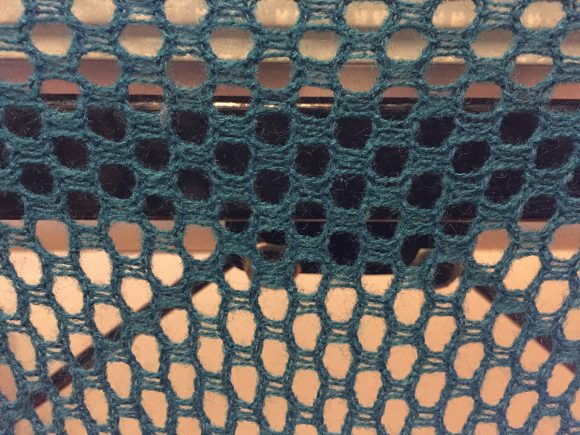
TIP: If you’ve never machine-knit lace before, you move the lace carriage from left to right, past the turn mark (just like regular knitting with the K carriage), across the needles until no needles are selected.The lace carriage always makes at least two passes across the bed, one from left to right, then back to the left side of the machine. Then the K carriage makes two passes, knitting two rows each time between lace passes.
Sometimes a pattern will require you to make many, many passes with the lace carriage to transfer all the stitches.If you are knitting on a Brother or Knitking with a working original board, you’ll see a “2” in the memo display when you need to use the K carriage. If you’re using AYAB, or another machine knitting hack, move the K carriage once no more needles are selected.
NOTE: I haven’t translated these lace pattern image files for AYAB yet, but I’m hoping to get to it soon.
5. Turn the K-carriage knob to “NL” for plain knitting.
6. Knit 6 rows in stockinette.
7. Program pattern #105 into your machine.
8. Knit with the lace carriage for 120 K carriage rows.
9. Knit 6 rows in stockinette.
10. Punch in pattern #104, knit 120 K carriage rows.
11. 6 rows stockinette.
12. Enter pattern #104, knit 12o K carriage rows.
13. Knit 5 rows in socking stitch.
14. Loosen the tension to 10 and knit one final row.
15. Bind off by hand or with a Brother linker accessory.
16. Remove the scarf from the machine.
17. Join the scarf’s top and bottom edges by hand with a tapestry needle or use a linker.
